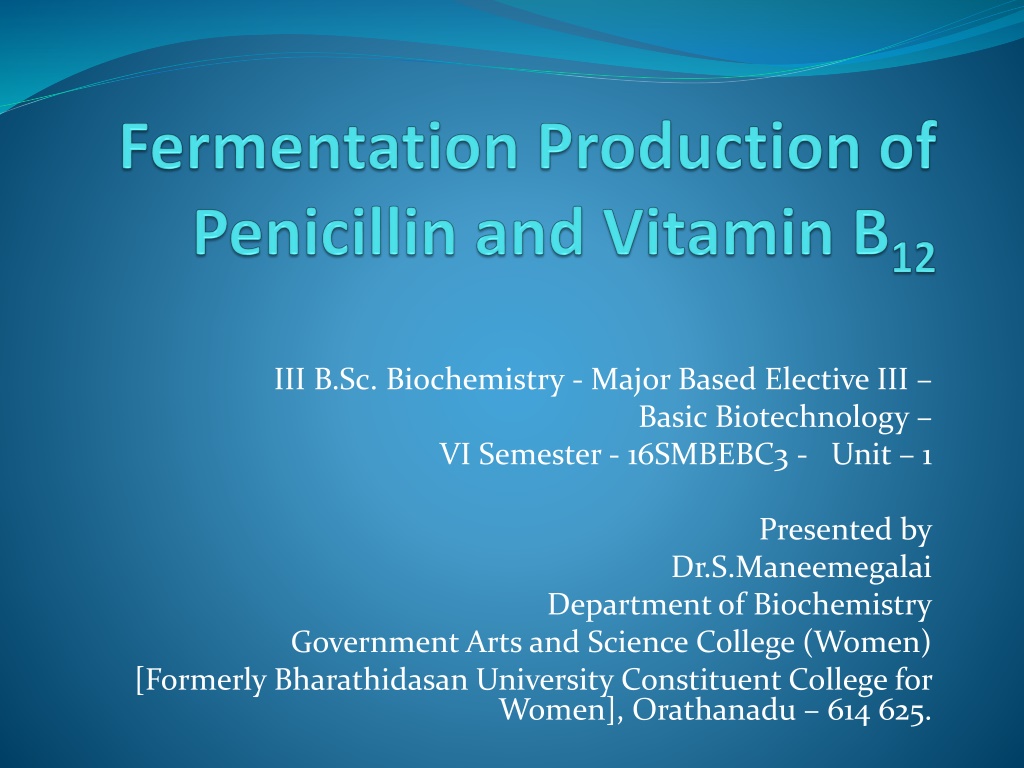Production of Penicillin in Biochemistry and Biotechnology
Penicillin is an antibiotic produced from high-yielding strains of Penicillium chrysogenum. The production process involves maintaining the strains as spore suspensions, inoculation methods, composition of inoculum, production medium requirements, and use of precursors like phenyl acetic acid derivatives. The raw materials in the production medium must support abundant mycelium growth, maximum penicillin production, and easy extraction and purification.
Uploaded on Sep 22, 2024 | 0 Views
Download Presentation

Please find below an Image/Link to download the presentation.
The content on the website is provided AS IS for your information and personal use only. It may not be sold, licensed, or shared on other websites without obtaining consent from the author. Download presentation by click this link. If you encounter any issues during the download, it is possible that the publisher has removed the file from their server.
E N D
Presentation Transcript
III B.Sc. Biochemistry - Major Based Elective III Basic Biotechnology VI Semester - 16SMBEBC3 - Unit 1 Presented by Dr.S.Maneemegalai Department of Biochemistry Government Arts and Science College (Women) [Formerly Bharathidasan University Constituent College for Women], Orathanadu 614 625.
Penicillin It is an antibiotic. Produced from high yielding strains of Penicillium chrysogenum. The high yielding strains are unstable. They are maintained as spore suspension in sterile inert support or lyophilised in appropriate media or stored under liquid nitrogen.
Requirements for production Inoculum Raw materials for Medium Production Extraction and Purification
Inoculum Composition of inoculum (sporulation) medium Glycerol 7.5 g/l Cane molasses 7.5 g/l Corn steep liquor 2.5 g/l Magnesium sulphate 0.050 g/l Potassium dihydrogen phosphate 0.060 g/l Peptone 5 g/l Sodium chloride 4 g/l Fe tartrate 0.005 g/l Copper sulphate 0.004 g/l Agar 2.5 g/l Distilled water 1 litre Temperature 24 C Sterilized and adequate sterilized air must be supplied
Inoculation Method Sodium lauryl sulphonate is used prepare a uniform of suspension of spores of high yielding Penicillium strains. After adding the suspension to production medium, the medium is agitated and aerated.
Production medium The raw materials in production medium must favour abundant growth of mycelium Produce maximum penicillin Easy to extract and purify penicillin. Raw materials: Carbon source: 6% lactose or glucose and sucrose Nitrogen source: Ammonium salts, ammonia gas or corn steep liquor Mineral source: Potassium, phosphorous, magnesium, sulphur, zinc and copper. Corn steep liquor provides some minerals. They are supplied as sulphates and phospates.
Precursors for penicillin production: The required penicillin is produced by the addition of phenyl acetic acid derivatives. Eg., Penicillin G (Benzyl Penicillin) Penicillin V (phenoxy methyl penicillin)
Medium for Penicillin production Corn steep liquor solids 3.5 % Lactose 3.5 % Glucose 1.0 % Calcium carbonate 1.0 % Potassium dihydrogen phosphate 0.4 % Edible oil 0.25 % Slower addition of penicillin precursor
Requirements Temperature 25 26 C pH - 5.5 to 6.0 ( Initially the pH remains constant and later rises to 7 to 7.5. Time duration: 3 to 5 days Aeration and agitation is required
Extraction and Purification 1. Removal of mycelium : Rotary vacuum filter is used. 2. Counter current solvent extraction : In acidified condition (pH 2 to 2.5) extraction is carried out qucikly, because penicillin is unstable at low pH. Again extracted at pH 7 to 7.5 in aqueous solution. 3. Treatment of crude extract: Converted to penicillin salts by using sodium hydroxide.
Vitamin B12 It is cyanocobalamin. Cobinamide molecule linked to a nucleotide Cobinamide having central cobalt linked to a cyanide surrounded by four reduced pyrrole ring.
Fermentation Production It requires 1. Microorganisms 2. Inoculum preparation 3. Medium (sterilized) 4. Required production condition 5. Recovery Mostly conducted by submerged culture method
Microorganisms Streptomyces olivaceus NRRL B-1125 commonly used. Other microorganisms: Streptomyces griseus, Bacillus megaterium, Bacillus coagulans, Pseudomonas denitrificans, Propionibacterium freudenreichii, Pseudomonas denitrificans
Inoculum Preparation Inoculum medium (composition) 1. Yeast extract 1.0 g/l 2. Beef extract 1.0 g/l 3. Enzymatic hydrolysateof casein 2.0 g/l 4. Glucose 10 g/l 5. Agar 15 g/l 6. Distilled water (pH 7.3) 1 litre
Inoculum preparation Pure agar slant culture of S. olivaceus NRRL B 1125 is inoculated in 250 ml of inoculation medium in a Erlenmeyer flask. It is placed on a mechanical shaker for aeration during incubation. Inoculum is produced to a 5% volume of production medium.
Production medium It contains carbohydrate, proteins, cobalt and other salts. Medium composition Distillers soluble 4 g/100ml Dextrose 0.5 1.0 g/100ml CaCO3 0.5 g/100ml Cobalt chloride 1.5 10 ppm pH 7.0 The medium is sterilized by heating at 250 F for 1 hour or by live steam at 330 F for 13 minutes
Optimum conditions Temperature : 80 F pH: It reduces in the first 24h and after 2 to 4 days rises. Aeration and agitation: Optimum aeration and correct agitation is required. Sterilized air : 0.5volume air/minute/volume medium Antifoam agent: Sterilized soya bean oil or corn oil or lard oil are added to prevent foam formation. Sterile condition to be maintained to get an optimum yield. Yield: 1-2 mg/litre
Recovery of Vitamin B12 Most of the cobalamin is associated with mycelium, it is boiled at pH 5 to liberate from mycelium. Filtered to remove mycelium Treated with cyanide to convert to cyanocobalamin Cyanocobalamin is adsorbed to adsorbent columns packed with adsorbent such as activated charcoal. Eluted and extracted. Evaporated and dried Yield: 10 30mg/lb
References Text books Industrial Microbiology L.E.Casida, Jr, Industrial Microbiology A.H. Patel Internet sources





























